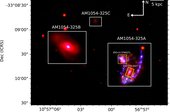 IIA JYOTI YADAV
IIA JYOTI YADAVThe morphology and kinematics of the galaxy group AM 1054-325: A MUSE perspective
Galaxy interactions in groups can lead to intense starbursts and the activation of active galactic nuclei (AGNs). The stripped gas from the outer disk can lead to star-forming clumps along the tidal tails or sometimes tidal dwarf galaxies. We investigate the impact of interaction on various galaxy properties, including morphology, star formation rates, and chemical composition in the galaxy group AM 1054-325 using Multi Unit Spectroscopic Explorer (MUSE) data. We conduct a comprehensive spatially and spectrally resolved investigation of the star formation rate, star formation histories, metallicity, and AGN activity. The galaxy subgroup AM 1054-325A shows multiple star-forming clumps in Hα emission along the western tidal tail, which are formed due to tidal stripping. These clumps also have higher metallicities. AM 1054-325B is quenched and shows disturbed gas kinematics and the signature of gas accretion in the Hα map. The specific star formation along the tidal tail is higher, contributing to the galaxy’s overall stellar mass growth.
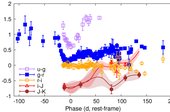 IIA RISHABH SINGH TEJA
IIA RISHABH SINGH TEJAThe enigmatic double-peaked stripped-envelope SN 2023aew
We present optical and near-infrared photometry and spectroscopy of SN 2023aew and our findings on its remarkable properties. This event, initially resembling a Type IIb supernova (SN), rebrightens dramatically ∼90 d after the first peak, at which time its spectrum transforms into that of a SN Ic. The slowly evolving spectrum specifically resembles a post-peak SN Ic with relatively low line velocities even during the second rise. The second peak, reached 119 d after the first peak, is both more luminous (Mr = −18.75 ± 0.04 mag) and much broader than those of typical SNe Ic. Blackbody fits to SN 2023aew indicate that the photosphere shrinks almost throughout its observed evolution, and the second peak is caused by an increasing temperature. Bumps in the light curve after the second peak suggest interaction with circumstellar matter (CSM) or possibly accretion. We consider several scenarios for producing the unprecedented behavior of SN 2023aew. Two separate SNe, either unrelated or from the same binary system, require either an incredible coincidence or extreme fine-tuning. A pre-SN eruption followed by a SN requires an extremely powerful, SNlike eruption (consistent with ∼1051 erg) and is also disfavored. We therefore consider only the first peak a true stellar explosion. The observed evolution is difficult to reproduce if the second peak is dominated by interaction with a distant CSM shell. A delayed internal heating mechanism is more likely, but emerging embedded interaction with a CSM disk should be accompanied by CSM lines in the spectrum, which are not observed, and is difficult to hide long enough. A magnetar central engine requires a delayed onset to explain the long time between the peaks. Delayed fallback accretion onto a black hole may present the most promising scenario, but we cannot definitively establish the power source.
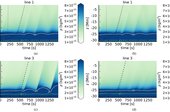 IIA TANMOY SAMANTA
IIA TANMOY SAMANTAModelling the connection between propagating disturbances and solar spicules
Propagating (intensity) disturbances (PDs) have been extensively reported in observations of coronal loops and polar plumes, along with more recent links to co-temporal spicule activity in the solar atmosphere. However, despite their appearance in observations, PDs have yet to be studied or modelled in depth. Methods. In this work, we present results from a three-dimensional magnetohydrodynamic (3D MHD) numerical model. It features a stratified solar atmosphere perturbed by a p-mode wave driver at the photosphere, subsequently forming spicules described by the rebound shock model. Results. We find the features of the detected PDs to be consistent with the co-temporal transition region dynamics and spicular activity resulting from non-linear wave steepening and shock formation. Furthermore, the PDs could be interpreted as slow magnetoacoustic pulses propagating along the magnetic field, rather than high-speed plasma upflows carrying sufficient energy flux to (at least partially) heat the lower coronal plasma. Using forward modelling, we demonstrate the similarities between the PDs in the simulations and those reported from observations with IRIS and SDO/AIA. Conclusions. Our results suggest that in the model presented here, the dynamical movement of the transition region is a result of wave dynamics and shock formation in the lower solar atmosphere. We find that PDs are launched co-temporally with the rising of the transition region, regardless of the wave-generating physical mechanisms occurring in the underlying lower solar atmosphere. However, it is clear that signatures of PDs appear much clearer when a photospheric wave driver is included. Finally, we present the importance of PDs in the context of providing a source for powering the (fast) solar wind.
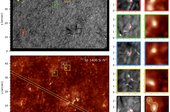 IIA JAYANT JOSHI
IIA JAYANT JOSHITransition region response to quiet-Sun Ellerman bombs
Quiet-Sun Ellerman bombs (QSEBs) are key indicators of small-scale photospheric magnetic reconnection events. Recent high-resolution observations have shown that they are ubiquitous and that large numbers of QSEBs can be found in the quiet Sun. Aims. We aim to understand the impact of QSEBs on the upper solar atmosphere by analyzing their spatial and temporal relationship with the UV brightenings observed in transition region diagnostics. Methods. We analyzed high-resolution Hβ observations from the Swedish 1-m Solar Telescope and utilized k-means clustering to detect 1423 QSEBs in a 51 min time series. We used coordinated and co-aligned observations from the Interface Region Imaging Spectrograph (IRIS) to search for corresponding signatures in the 1400 Å slit-jaw image (SJI) channel and in the Si IV 1394 Å and Mg II 2798.8 Å triplet spectral lines. We identified UV brightenings from SJI 1400 using a threshold of 5σ above the median background. Results. We focused on 453 long-lived QSEBs (> 1 min) and found 67 cases of UV brightenings from SJI 1400 occurring near the QSEBs, both temporally and spatially. Temporal analysis of these events indicates that QSEBs start before UV brightenings in 57% of cases, while UV brightenings lead in 36% of instances. The majority of the UV brightenings occur within 1000 km of the QSEBs in the direction of the solar limb. We also identify 21 QSEBs covered by the IRIS slit, four of which show emissions in the Si IV 1394 Å and/or Mg II 2798.8 Å triplet lines, at distances within 500 km of the QSEBs in the limb direction. Conclusions. We conclude that a small fraction (15%) of the long-lived QSEBs contribute to the localized heating observable in transition region diagnostics, indicating they play a minimal role in the global heating of the upper solar atmosphere.
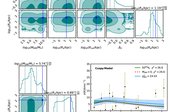 IIA ADITYA, K
IIA ADITYA, KChallenges in modeling the dark matter halo of NGC 1052–DF2: Cored versus cuspy halo models
The discovery of NGC 1052−DF2 and subsequent modeling have shown that NGC 1052−DF2 is deficient in dark matter and is in conflict with the standard stellar-to-halo mass ratio. In this work, we aim to resolve the degeneracy between the dynamical models on the mass estimate of the NGC 1052−DF2. Methods. We constructed mass models of NGC 1052−DF2 using an anisotropic distribution function with a radially varying anisotropy parameter and studied the effect of the various model parameters on the dark matter estimates. We used the observed stellar photometry as an input parameter to construct the distribution function and employed a Markov chain Monte Carlo (MCMC) method to estimate the dark matter model parameters. Results. We find that mass models with a cuspy dark matter halo have comparable χ2 to models with zero dark matter. Moreover, the cuspy dark matter halo fails to consistently account for the observed velocity dispersion in the inner and outer regions of the galaxy. Consequently, we rule out the possibility of a cuspy dark matter halo for describing the mass models of NGC 1052−DF2. Our study shows that the cored dark matter halo model with a total mass of log(MDM/M⊙) = 10.5 explains the observed kinematics but requires an extraordinarily large scale length (20 kpc) and an outer cutoff radius (26 kpc). While the cored mass model provides a comparatively better fit, our findings emphasize that the mass models are largely unconstrained by the available kinematic data. Our results suggest that NGC 1052−DF2 may not only have an ultra-diffuse stellar distribution but that it can, within uncertainties in the available kinematic data, potentially host an ultra-diffuse dark matter distribution compatible with the standard stellar-to-halo mass relation (SHMR) predicted by galaxy formation and evolution models
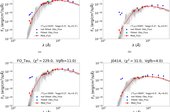 IIA ANNAPURNI SUBRAMANIAM
IIA ANNAPURNI SUBRAMANIAMSimultaneous far-ultraviolet and near-ultraviolet observations of T Tauri stars with UVIT/AstroSat: Probing the accretion process in young stars
We present results from simultaneous far-ultraviolet (FUV) and near-ultraviolet (NUV) observations of T Tauri stars (TTSs) in the Taurus molecular cloud with UVIT/AstroSat. This is the very first UVIT study of TTSs. From the spectral energy distribution of TTSs from FUV to IR, we show that classical TTSs (CTTSs) emit significantly higher UV excess compared to weak-line TTSs (WTTSs). The equivalent blackbody temperatures corresponding to the UV excess in CTTSs (>104 K) are also found to be relatively higher than those in WTTSs (<9250 K). From the UV excess, we have reclassified two WTTSs (BS Tau and V836 Tau) as CTTSs, which has been supported by the follow-up optical spectroscopic study using the Himalayan Chandra Telescope, showing strong Hα line emission. We find that CTTSs show strong excess emission in both the FUV (>107) and NUV (>103) bands, while WTTSs show strong excess only in the FUV (105), suggesting that excess emission in the NUV can be used as a tool to classify the TTSs. We also find a linear correlation between UV luminosity (a primary indicator of mass accretion) and Hα luminosity (a secondary indicator of mass accretion) with a slope of 1.20 ± 0.22 and intercept of 2.16 ± 0.70
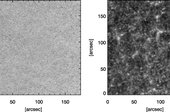 IIA RAJAGURU, S. P
IIA RAJAGURU, S. PInvestigation of phase shift and travel time of acoustic waves in the lower solar atmosphere using multiheight velocities
We report and discuss the phase shift and phase travel time of low-frequency (ν < 5.0 mHz) acoustic waves estimated within the photosphere and photosphere–chromosphere interface regions, utilizing multiheight velocities in the quiet Sun. The bisector method has been employed to estimate seven height velocities in the photosphere within the Fe I 6173 Å line scan, while nine height velocities are estimated from the chromospheric Ca II 8542 Å line scan observations obtained from the narrowband imager instrument installed on the Multi-Application Solar Telescope operational at the Udaipur Solar Observatory, India. Utilizing a fast Fourier transform at each pixel over the full field of view, phase shift and coherence have been estimated. The frequency and height-dependent phase shift integrated over the regions having an absolute line-of-sight magnetic field of less than 10 G indicates the nonevanescent nature of low-frequency acoustic waves within the photosphere and photosphere–chromosphere interface regions. Phase travel time estimated within the photosphere shows nonzero values, aligning with previous simulations and observations. Further, we report that the nonevanescent nature persists beyond the photosphere, encompassing the photospheric–chromospheric height range. We discuss possible factors contributing to the nonevanescent nature of low-frequency acoustic waves. Additionally, our observations reveal a downward propagation of high-frequency acoustic waves indicating refraction from higher layers in the solar atmosphere. This study contributes valuable insights into the understanding of the complex dynamics of acoustic waves within different lower solar atmospheric layers, shedding light on the nonevanescent nature and downward propagation of the acoustic waves.
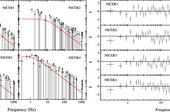 IIA DEBJIT CHATTERJEE
IIA DEBJIT CHATTERJEEAccretion properties of soft X-Ray transient XTE J1856+053 during its 2023 outburst
Soft X-ray transients (SXTs) are a subclass of the low-mass X-ray binaries that occasionally show a sudden rise in their soft X-ray luminosity; otherwise, they remain in an extremely faint state. We investigate the accretion properties of the SXT XTE J1856+053 during its 2023 outburst obtained by NICER and NuSTAR data in July. We present detailed results on the timing and spectral analysis of the X-ray emission during the outburst. The power spectral density shows no quasi-periodic oscillation features. The source’s spectrum on July 19 can be well fitted with a multicolor blackbody component, a power-law component, and a reflection component with a broadened iron emission line. NICER spectra can be well fitted by considering a combination of a blackbody and a power law. The source exhibits a transition within just 5 days from a soft state to an intermediate state during the outburst decline phase. The inner accretion disk has a low inclination angle (∼18°). The spectral analysis also suggests a high-spin (a > 0.9) black hole as the central accreting object.
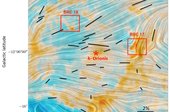 IIA ARCHANA SOAM
IIA ARCHANA SOAMOptical polarimetry study of the Lambda-Orionis star-forming region
We present an optical polarimetry study of the nearby star-forming region Lambda-Orionis to map the plane-of-the-sky magnetic field geometry to understand the magnetized evolution of the HII region and the associated small molecular clouds. We made multiwavelength polarization observations of 34 bright stars distributed across the region. We also present the R-band polarization measurements that focused on the small molecular clouds, bright-rimmed clouds (BRC), BRC 17, and BRC 18, which are located at the periphery of the HII region. The magnetic field lines exhibit a large-scale ordered orientation consistent with the Planck submillimeter polarization measurements. The magnetic field lines in the two BRCs are found to be roughly in north-south directions. However, a larger dispersion is noted in the orientation for BRC 17 compared to BRC 18. Using a structure-function analysis, we estimate the strength of the plane-of-the-sky component of the magnetic field as ∼28 µG for BRC 17 and ∼40 µG for BRC 18. The average dust grain size and the mean value of the total-to-selective extinction ratio (RV ) in the HII region are found to be ∼0.51 ± 0.05 µm and ∼2.9 ± 0.3, respectively. The distance of the whole HII region is estimated as ∼392 ± 8 pc by combining astrometry information from Global Astrometric Interferometer for Astrophysics (Gaia) early data release 3 (EDR3) for young stellar objects associated with BRCs and confirmed members of the central cluster Collinder 69.
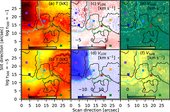 IIA HARSH MATHUR
IIA HARSH MATHURSimultaneous Spectropolarimetric Observations in the Hα and Ca II 8662Å Lines of an Active Region
We present spectropolarimetric observations of an active region recorded simultaneously in the Hα and the Ca II 8662 Å lines. The sunspot exhibits multiple structures, including a light bridge and a region where the Ca II 8662 Å line core is in emission. Correspondingly, the Hα line core image displays brightening in the emission region, with the spectral profiles showing elevated line cores. The stratification of the line-of-sight magnetic field is inferred through nonlocal thermodynamic equilibrium multiline inversions of the Ca II 8662 Å line and the weak field approximation (WFA) over the Hα line. The field strength inferred from the Hα line core is consistently smaller than that inferred from inversions at log t500 = −4.5. However, the study finds no correlation between the WFA over the core of the Hα line and that inferred from inversions at log t500 = −4.5. In regions exhibiting emission features, the morphology of the magnetic field at log t500 = −4.5 resembles that at log t500 = −1, with slightly higher or comparable field strengths. The magnetic field morphology inferred from the core of the Hα line is also similar to that inferred from the full spectral range of the Hα line in the emission region. The field strength inferred in the light bridge at log t500 = −1 is smaller than the surrounding umbral regions and comparable at log t500 = −4.5. Similarly, the field strength inferred in the light bridge from the WFA over the Hα line appears lower compared to the surrounding umbral regions.